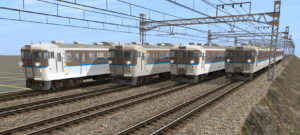
Left: 115 Series (Hiroshima refurbished), 115 Series (Kansai refurbished), 113 Series (Hiroshima refurbished) and 113 Series (Kansai refurbished).
DOWNLOAD
This is a reskin of Keinchiro’s 113 Series upgraded by Hirochi. All the necessary dependencies are included in this package or are avaible on the DLS.
By the late 1990s, JR West had spent most of it’s money to replace the most worn-out trains in it’s fleet (namely the 101 Series EMUs and the KiHa 35 and 52 DMUs), therefore it could no longer afford vast-scale replacements, but only very gradual ones. At the same time, most of the 113 and 115 Series fleet, wich was the backbone of regional and local services, had already reached 30 odd years of service.
With no money left to replace them, JR West decided instead to refurbish them.
This program, called “N40” (or “a lifespan of 40 more years from the refurbishment”) was started in 1998, and involved the complete repairation of the bodyshell, the improvement of noise and heat insulation, the replacement of the passenger and the cab windows with newer ones made of a special type of reinforced glass, the reworking of the underfloor wiring, the repainting of the passenger compartment, the replacement of the old seats with newer ones (similar to those used on the 223 Series) and many, many more…
Finally, all the refurbished trains were to be repainted into a new livery, wich was to replace the iconic Shonan one (and also a few “line-specific” others). This new livery was sober but elegant, with a cream background with brown window bands and a thin blue line (JR West’s company colour) and it was soon nicknamed “Café Au Lait” by railfans.
Trains refurbished at the Hiroshima depot had their own livery variant: a white instead of cream background color.
The first N40 refurbished trains re-entered service in 1998, on Kansai area trunk lines (such as the Tokaido or San’yo Main Lines or the Kosei, Hanwa and Fukuchiyama Lines).
In 2002, it was decided to simplify part of the refurbishment program. Now called “N30”, one of the key differences was in the passenger’s windows wich were left to the original type. The livery instead, remained the same.
By the late 2000s, as newer trains were slowly being introduced, the deployment of the 115 and 113 Series fleet (both refurbished and non-refurbished trains) was reorganized and regrouped into two areas: the Setouchi area (from Okayama to Hiroshima and Shimonoseki) and the Kyoto-Kitakinki Area (lines north of Kyoto, such as the Kosei and Sagano lines). With this reorganization into these two areas, two new liveries were designed to replace all the older ones, standardizing the fleet’s appearance: the “Seotuchi Yellow” and the “Kyoto-Kitakinki Green”.
The transferring process was slow but steady, with 113s and 115s being reassigned and repainted at a constant rate, some surplus trains from the Kansai area also ended up (still in their livery) on the San’yo Main Line, where they ran for sometime alongside the “native” 113s and 115s in their “Hiroshima refurbished” livery.
By 2016, the last 113 Series in the “Hiroshima refurbished” livery was repainted into the “Setouchi Yellow”, followed a year later by the last “Kansai refurbished”-liveried one (wich, as it had been transferred to the Setouchi area was itself too repainted into the “Setouchi Yellow” livery).
Nowdays, 113 and 115 Series trains in JR West have all been repainted into either the Setouchi Yellow or Kyoto-Kitakinki Green liveries. As such, there are no longer trains in service colored in the “Café au Lait” livery (nor in any other livery, for that matter).
113 and 115 Series Mixed Consists download page
